Galaxies in the News
Milky Way may have formed 'inside-out': Gaia provides new insight into Galactic evolution PhysOrg - January 20, 2014
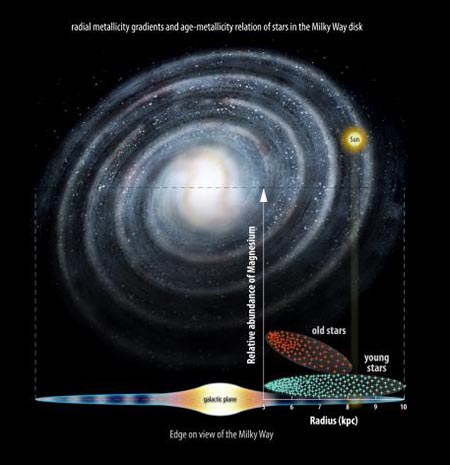
A breakthrough using data from the Gaia-ESO project has provided evidence backing up theoretically predicted divisions in the chemical composition of the stars that make up the Milky Way's disc – the vast collection of giant gas clouds and billions of stars that give our Galaxy its 'flying saucer' shape.
Galaxies
Milky Way shaken... and stirred PhysOrg - January 20, 2014
team of scientists headed by Ivan Minchev from the Leibniz Institute for Astrophysics Potsdam (AIP), has found a way to reconstruct the evolutionary history of our galaxy, the Milky Way, to a new level of detail. The investigation of a data set of stars near the Sun was decisive for the now published results. The astronomers studied how the vertical motions of stars - in the direction perpendicular to the galactic disc - depend on their ages. Because a direct determination of the age of stars is difficult, the astronomers instead analyzed the chemical composition of stars: an increase in the ratio of magnesium to iron ([Mg/Fe]) points to a greater age.
Scientific American - November 22, 2013
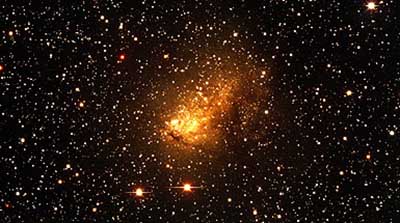
Two dwarf galaxies may have smashed together in our Local Group, sparking the nearest "starburst". Giant galaxies such as the Milky Way and its neighbor Andromeda originated long ago after smaller galaxies crashed together and grew larger. Observing this process in action, however, is difficult because it requires detecting collisions between dwarf galaxies near the edge of the observable universe, where we see galaxies as they appeared more than 10 billion years ago. Now astronomers have uncovered evidence of a similar collision much closer to home - a mere 2.6 million light-years from Earth - in a small galaxy named IC 10, allowing them to watch a dwarf–dwarf smashup in detail.
New galaxy 'most distant' yet discovered BBC - October 23, 2013
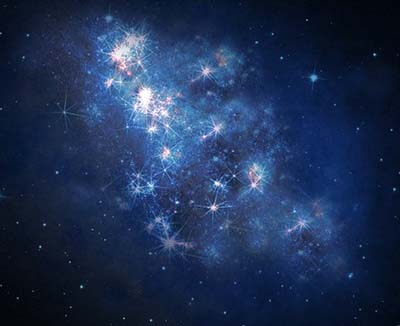
The galaxy is about 30 billion light-years away and is helping scientists shed light on the period that immediately followed the Big Bang.
Ancient Galaxy Is Farthest Ever Seen Live Science - October 23, 2013
By using data collected by the Hubble Space Telescope and observations from the Keck I telescope at the Keck Observatory in Hawaii, astronomers have now confirmed that the galaxy designated z8_GND_5296 formed within 700 million years after the beginning of the universe, making it the oldest and most distant galaxy ever verified.
The peanut at the heart of our galaxy PhysOrg - September 12, 2013
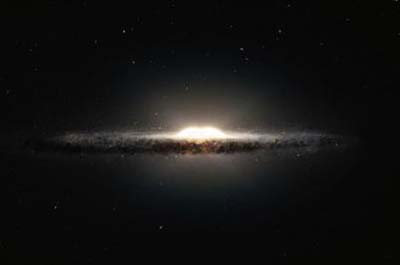
This artist's impression shows how the Milky Way galaxy would look seen from almost edge on and from a very different perspective than we get from the Earth. The central bulge shows up as a peanut shaped glowing ball of stars and the spiral arms and their associated dust clouds form a narrow band. Two groups of astronomers have used data from ESO telescopes to make the best three-dimensional map yet of the central parts of the Milky Way. They have found that the inner regions take on a peanut-like, or X-shaped, appearance from some angles. This odd shape was mapped by using public data from ESO's VISTA survey telescope along with measurements of the motions of hundreds of very faint stars in the central bulge.
Astronomers discover star racing around black hole at Milky Way center PhysOrg - October 4, 2012
UCLA astronomers report the discovery of a remarkable star that orbits the enormous black hole at the center of our Milky Way galaxy in a blistering 11-and-a-half years - the shortest known orbit of any star near this black hole.
Hidden galactic nuclei PhysOrg - August 10, 2012
At the core of most galaxies including our own Milky Way is a massive black hole. Material falling into the environment of the black hole heats up, and can radiate dramatically, sometimes also powering the ejection of bipolar jets of rapidly moving charged particles. These so-called active galactic nuclei (AGN) are observed to have roughly two types of characteristics: bright, rapidly moving hot gas with dust emission features, or dust absorption with modest (or no) fast gas.
Huge "Structure" of Satellites Found Orbiting Milky Way National Geographic - May 1, 2012
A huge "structure" of satellite galaxies and star clusters has been found wheeling around the Milky Way, according to a new study. The discovery surprised scientists, in part because the structure might spell trouble for theories of dark matter, the mysterious, invisible substance that's thought to make up about 23 percent of the mass in the universe. The finding is only the latest to question dark matter's existence—last week, for instance, astronomers announced that they'd failed to detect dark matter in the sun's neighborhood, even though the substance should be there, according to accepted theory.
Rare "Emerald Cut" Galaxy Found National Geographic - March 21, 2012
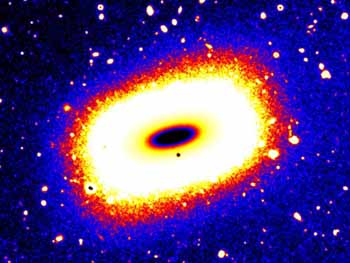
Not only are there diamonds in the sky, some of them are emerald-cut sparklers, according to astronomers who've found an unusual rectangular galaxy. The cosmic oddball, dubbed LEDA 074886, is a dwarf galaxy 70 million light-years away in the constellation Eridanus, the River. Most galaxies exist in one of three forms: a disk with spiral arms (such as our Milky Way), a football-shaped ellipsoid, or an irregular, lumpy blob. But LEDA 074886 is a remarkably symmetrical rectangle, akin to an emerald-cut gem.
Astronomers weigh in on Milky Way's true colors BBC - January 12, 2012
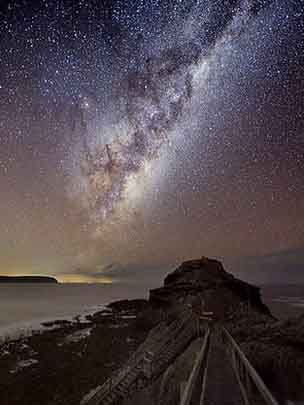
Astronomers have determined exactly what color our home galaxy the Milky Way is - and find it is aptly named. They wanted to find out how our galaxy looked from the outside - a difficult task given the Earth is inside it. A comparison of star types in other galaxies gives perhaps an unsurprising result: white. But not just any white: specifically, like spring snow at an hour after sunrise or before sunset.
Astronomers determine color of the Milky Way Galaxy PhysOrg - January 11, 2012
A team of astronomers in Pitt's Kenneth P. Dietrich School of Arts and Sciences announced today the most accurate determination yet of the color of the (aptly named) Milky Way Galaxy: "a very pure white, almost mirroring a fresh spring snowfall."
Coming Face-to-Face With Our Galaxy's Black Hole Discovery - December 19, 2011
At the center of our galaxy resides an invisible monster, a dark giant composed of the shredded and swallowed remains of stars, nebulae and solar systems. It has captured enormous nearby stars into orbit, causing them to whip around the galactic center at breakneck speeds until they too become just another snack. It may sound like science fiction but all observations indicate it's indeed a fact: a supermassive black hole - called Sagittarius A* - exists. It's real, it's huge, and it's hungry. Sagittarius A* is a monstrous black hole estimated to contain the mass equivalent to 4 million suns, packed into a space less than the distance between Earth and the sun, resulting in an incredibly dense object known as a black hole -- in the case of Sgr A*, a supermassive black hole. Although Sgr A* is itself invisible the effect of its gravity on surrounding stars has been seen, some of which orbit it at speeds of over 600 miles per second!
In a Star's Final Days, Astronomers Hunt 'Signal of Impending Doom' Science Daily - December 1, 2011
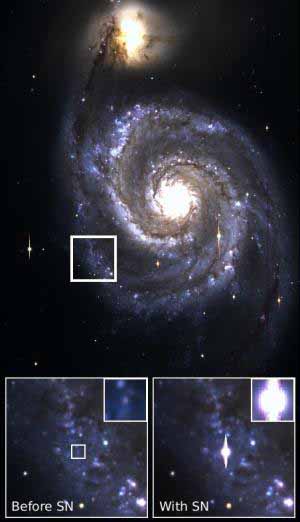
An otherwise nondescript binary star system in the Whirlpool Galaxy has brought astronomers tantalizingly close to their goal of observing a star just before it goes supernova. In the first survey of its kind, the researchers have been scanning 25 nearby galaxies for stars that brighten and dim in unusual ways, in order to catch a few that are about to meet their end. In the three years since the study began, this particular unnamed binary system in the Whirlpool Galaxy was the first among the stars they've cataloged to produce a supernova.
Unexpectedly Heavy Stars from Long Ago Puzzle Astronomers Live Science - December 1, 2011
Ancient stars found in the outer reaches of our Milky Way are surprisingly chock full of some of the heaviest chemical elements, which could have formed in the galaxy's early history, a new study reveals. When astronomers found abnormally large amounts of heavy elements like gold, platinum and uranium in some of the oldest stars in the Milky Way they were puzzled, because an abundance of very heavy metals is typically only seen in much later generations of stars. To investigate this mystery, researchers observed these ancient stars over the course of several years using the European Southern Observatory's fleet of telescopes in Chile. They trained their telescopes on 17 "abnormal" stars in the Milky Way that were found to be rich in the heaviest chemical elements.
Voyager Probes Detect "Invisible" Milky Way Glow National Geographic - December 1, 2011
Speeding toward interstellar space, NASA's twin Voyager probes have now truly peered outside the solar system - and they've seen something no human has glimpsed before. According to a new study, the two spacecraft have detected a type of ultraviolet light from other regions of our Milky Way galaxy that had previously been all but invisible due to the sun's glow.
 A planet made of diamond PhysOrg - August 25, 2011
A planet made of diamond PhysOrg - August 25, 2011
A once-massive star that's been transformed into a small planet made of diamond: that is what University of Manchester astronomers think they've found in the Milky Way.
Saturn has rings - this planet has diamonds MSNBC - August 25, 2011
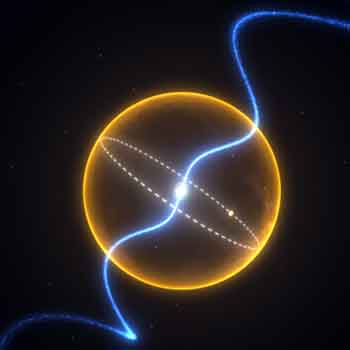
A newly discovered alien planet that formed from a dead star is a real diamond in the rough. The super-high pressure of the planet, which orbits a rapidly pulsing neutron star, has likely caused the carbon within it to crystallize into an actual diamond, a new study suggests. The composition of the planet, which is about five times the size of Earth, is not its only outstanding feature.
"Diamond" Planet Found; May Be Stripped Star Live Science - August 25, 2011
The newfound planet orbits the pulsar so closely the entire system would fit inside the sun. An exotic planet as dense as diamond has been found in the Milky Way, and astronomers think the world is a former star that got transformed by its orbital partner. The odd planet was discovered orbiting what's known as a millisecond pulsar - a tiny, fast-spinning corpse of a massive star that died in a supernova. Astronomers estimate that the newfound planet is 34,175 miles (55,000 kilometers) across, or about five times Earth's diameter.
Striking Photo Looks Into the 'Eyes' of Cosmic Virgin Live Science - August 25, 2011
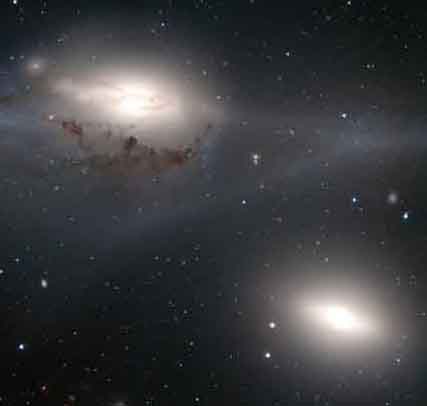
A spectacular new photo from an observatory in Chile has snapped a spectacular photo of two peculiar galaxies that scientists call "The Eyes." The new photo, released today (Aug. 24), shows a view of the Eyes from the European Southern Observatory's Very Large Telescope. The Eyes are about 50 million light-years away in the constellation of Virgo (The Virgin) and are some 100,000 light-years apart. The cores of the two galaxies are bright white ovals that resemble a pair of eyes glowing in the dark when seen in a moderate-sized telescope, ESO officials said.
Galaxy sized twist in time pulls violating particles back into line PhysOrg - July 14, 2011
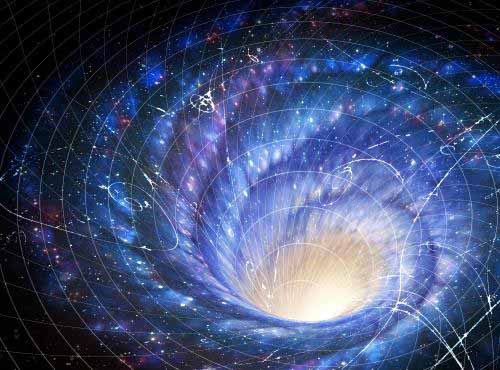
University of Warwick physicist has produced a galaxy sized solution which explains one of the outstanding puzzles of particle physics, while leaving the door open to the related conundrum of why different amounts of matter and antimatter seem to have survived the birth of our Universe.
Most elliptical galaxies are 'like spirals' PhysOrg - June 20, 2011
The majority of 'elliptical' galaxies are not spherical but disc-shaped, resembling spiral galaxies such as our own Milky Way with the gas and dust removed, new observations suggest.
New Photos Show Lopsided Galaxy Called 'Meathook' Live Science - May 10, 2011
The asymmetrical Meathook galaxy, or NGC 2442, has one spiral arm tightly folded in on itself and is the site of a recent supernova. The other arm, which is dotted with recent star formation, extends far out from the galactic nucleus.
 Astronomers find most distant galaxy candidate yet seen PhysOrg - January 26, 2011
Astronomers find most distant galaxy candidate yet seen PhysOrg - January 26, 2011
Pushing the Hubble Space Telescope to the limit of its technical ability, an international collaboration of astronomers have found what is likely to be the most distant and ancient galaxy ...
Hubble telescope detects the oldest known galaxy BBC - January 26, 2011
The Hubble Space Telescope has detected what scientists believe may be the oldest galaxy ever observed. It is thought the galaxy is more than 13 billion years old and existed 480 million years after the Big Bang. A Nasa team says this was a period when galaxy formation in the early Universe was going into "overdrive".
Dark-Matter Galaxy Detected: Hidden Dwarf Lurks Nearby? National Geographic - January 15, 2011
Signs point to an invisible "Galaxy X" just outside our own. An entire galaxy may be lurking, unseen, just outside our own. The invisibility of "Galaxy X"- as the purported body has been dubbed - may be due less to its apparent status as a dwarf galaxy than to its murky location and its overwhelming amount of dark matter, astronomer Sukanya Chakrabarti speculates. Detectable only by the effects of its gravitational pull, dark matter is an invisible material that scientists think makes up more than 80 percent of the mass in the universe.
The impact of double black holes and radio galaxies in the Milky Way PhysOrg - January 4, 2011
Radio galaxies beam as much as one trillion solar-luminosities of radiation into space at radio wavelengths. They are therefore cosmic beacons, and the light from the most distant ones known was emitted back when the universe was only a few billions of years old (compared with its age today of about 13.7 billion years). The origin of this intense emission is thought to lie in the hot environment of a massive black hole at the galaxy's nucleus, with the radio emission being produced by electrons moving rapidly in strong magnetic fields. Astronomers seeking to better understand galaxies in general, and the context of the Milky Way's origins, want to know when and how radio galaxies formed, how they evolved, and how they impact their environments.
Mysterious Structures Balloon From Milky Way's Core National Geographic - November 10, 2010
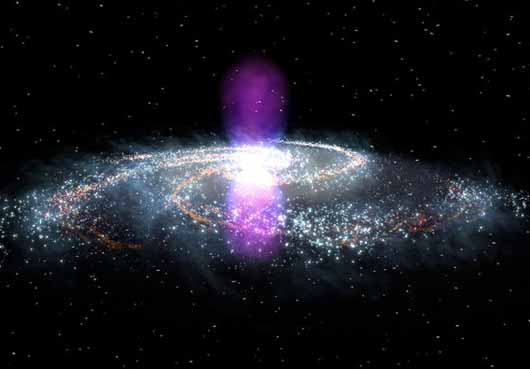
 Fermi telescope discovers new giant structure in our galaxy PhysOrg - November 9, 2010
Fermi telescope discovers new giant structure in our galaxy PhysOrg - November 9, 2010
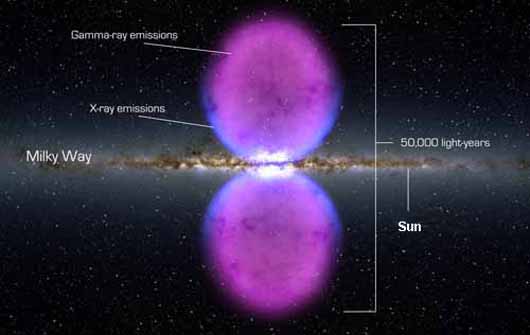
NASA's Fermi Gamma-ray Space Telescope has unveiled a previously unseen structure centered in the Milky Way. The feature spans 50,000 light-years and may be the remnant of an eruption from a supersized black hole at the center of our galaxy.
Bubbles of Energy Are Found in Galaxy New York Times - November 10, 2010
Something big is going on at the center of the galaxy, and astronomers are happy to say they don’t know what it is.
Huge Gamma Ray Bubbles Found Around Milky Way NASA - November 10, 2010
Did you know that our Milky Way Galaxy has huge bubbles emitting gamma rays from the direction of the galactic center? Neither did anybody. As the data from the Earth-orbiting Fermi satellite began acuminating (tapering gradually to a sharp point) over the past two years, however, a large and unusual feature toward our Galaxy's center became increasingly evident. The two bubbles are visible together as the red and white spotted oval surrounding the center of the above all sky image, released yesterday. The plane of our Galaxy runs horizontally across the image center. Assuming the bubbles emanate from our Galaxy's center, the scale of the bubbles is huge, rivaling the entire Galaxy in size, and spanning about 50,000 light years from top to bottom. Earlier indications of the bubbles has been found on existing all sky maps in the radio, microwave, and X-ray. The cause of the bubbles is presently unknown, but will likely be researched for years to come.
Space telescopes reveal previously unknown brilliant X-ray explosion in our Milky Way galaxy PhysOrg - October 22, 2010
Astronomers in Japan, using an X-ray detector on the International Space Station, and at Penn State University, using NASA's Swift space observatory, are announcing the discovery of an object newly emitting X-rays, which previously had been hidden inside our Milky Way galaxy in the constellation Centaurus.
Universe's Most Distant Object Spotted National Geographic - October 20, 2010
Galaxy emitted light just 600 million years after the big bang. A galaxy 13.12 billion light-years from Earth is the most distant object yet detected, a new study says. Astronomers spotted a faint glimmer of infrared light from this primitive galaxy, called UDFy-38135539, using the European Southern Observatory's Very Large Telescope in Chile.
Galaxy is most distant object yet BBC - October 20, 2010
A tiny faint dot in a Hubble picture has been confirmed as the most distant galaxy ever detected in the Universe. This collection of stars is so far away its light has taken more than 13 billion years to arrive at Earth.
'Galactic archaeologists' find origin of Milky Way's ancient stars PhysOrg - June 29, 2010
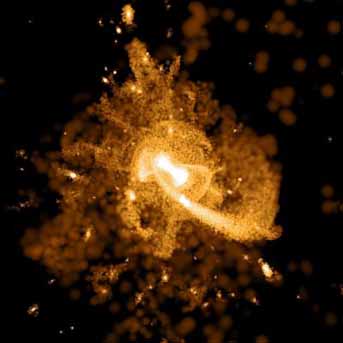
Many of the Milky Way's ancient stars are remnants of other smaller galaxies torn apart by violent galactic collisions around five billion years ago ...
Scientists get a look at the birth of the Milky Way PhysOrg - June 22, 2010
For the first time, a team of astronomers has succeeded in investigating the earliest phases of the evolutionary history of our home Galaxy, the Milky Way. The scientists, from the Argelander Institute for Astronomy at Bonn University and the Max-Planck Institute for Radioastronomy in Bonn, deduce that the early Galaxy went from smooth to clumpy in just a few hundred million years.
VISTA Views the Sculptor Galaxy Science Daily - June 21, 2010
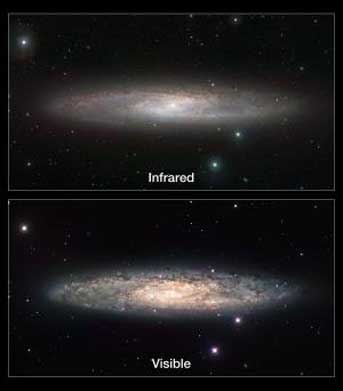
A spectacular new image of the Sculptor Galaxy (NGC 253) has been taken with the European Southern Observatory's VISTA telescope at the Paranal Observatory in Chile as part of one of its first major observational campaigns. By observing in infrared light VISTA's view is less affected by dust and reveals a myriad of cooler stars as well as a prominent bar of stars across the central region. The VISTA image provides much new information on the history and development of the galaxy.
'Monster' Black Holes Activate When Galaxies Collide Space.com - June 21, 2010
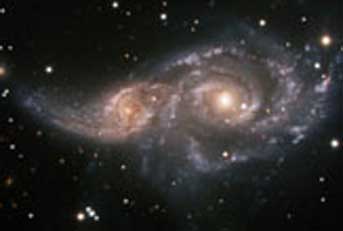
Enormous black holes, some of the most powerful sources of radiation in the universe, apparently switch on after galaxies collide, researchers have found. The centers of as many as a tenth of all galaxies generate more energy than can be explained by stars, with some of these "active galactic nuclei" releasing more radiation than the entire Milky Way galaxy combined, but from a space no larger than our solar system. Astronomers suspect this energy is released when matter falls into giant, supermassive black holes that are up to billions of times the mass of our sun at these galaxies' cores.
Astronomers discover clue to origin of Milky Way gas clouds PhysOrg - May 26, 2010
A surprising discovery that hydrogen gas clouds found in abundance in and above our Milky Way Galaxy have preferred locations has given astronomers a key clue about the origin of such clouds, which play an important part in galaxy evolution. The astronomers studied gas clouds in two distinct regions of the Galaxy. The clouds they studied are between 400 and 15,000 light-years outside the disk-like plane of the Galaxy. The disk contains most of the Galaxy's stars and gas, and is surrounded by a "halo" of gas more distant than the clouds the astronomers studied.
Origins of the Milky Way PhysOrg - March 20, 2010
According to current astronomical models, the Milky Way and other large galaxies formed over billions of years in a process that involved interactions between smaller galaxies, and in particular the gradual capture of many stars from nearby dwarf galaxies (small galaxies with hundreds or thousands of times fewer stars than the Milky Way). Our current galactic neighborhood hosts one other comparably large galaxy, Andromeda, and several dozen dwarf galaxies of various types, including the so-called Magellanic Clouds and a dwarf galaxy called the Sculptor Dwarf Galaxy. Astronomers piecing together the history of the Milky Way, including its genetic heritage from neighbors, recognize that our story also very likely reflects the cosmic story of how galaxies everywhere are assembled.
Old star is 'missing link' in galactic evolution PhysOrg - March 3, 2010
A newly discovered star outside the Milky Way has yielded important clues about the evolution of our galaxy. Located in the dwarf galaxy Sculptor some 280,000 light-years away, the star has a chemical make-up similar to the Milky Way's oldest stars, supporting theories that our galaxy grew by absorbing dwarf galaxies and other galactic building blocks.
Home Computers Around the World Unite to Map the Milky Way Science Daily - February 11, 2010
At this very moment, tens of thousands of home computers around the world are quietly working together to solve the largest and most basic mysteries of our galaxy. Enthusiastic and inquisitive volunteers from Africa to Australia are donating the computing power of everything from decade-old desktops to sleek new netbooks to help computer scientists and astronomers at Rensselaer Polytechnic Institute map the shape of our Milky Way galaxy. Now, just this month, the collected computing power of these humble home computers has surpassed one petaflop, a computing speed that surpasses the world's second fastest supercomputer.
Hubble Reaches the 'Undiscovered Country' of Primeval Galaxies PhysOrg - January 5, 2010
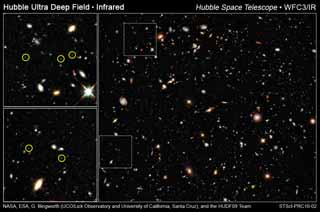
NASA's Hubble Space Telescope has broken the distance limit for galaxies and uncovered a primordial population of compact and ultra-blue galaxies that have never been seen before. The deeper Hubble looks into space, the farther back in time it looks, because light takes billions of years to cross the observable Universe. This makes Hubble a powerful "time machine" that allows astronomers to see galaxies as they were 13 billion years ago, just 600 million to 800 million years after the Big Bang.
Scientists reveal Milky Way's magnetic attraction PhysOrg - January 6, 2010
An international research project involving the University of Adelaide has revealed that the magnetic field in the centre of the Milky Way is at least 10 times stronger than the rest of the Galaxy. The evidence is significant because it gives astronomers a lower limit on the magnetic field, an important factor in calculating a whole range of astronomical data.
Researchers from the Max-Planck-Institute for Nuclear Physics, the University of Adelaide, Monash University and the United States have published their findings in Nature this week.
Some of the Universe's First Galaxies Discovered Space.com - November 6, 2009
A new survey has found 22 of the earliest galaxies to form in the universe, confirming the age of one at just 787 million years after the theoretical Big Bang. These and other galaxies from the universe?s childhood could help shed light on the conditions that governed the early universe.
Stars Fueled by Dark Matter Could Hold Secrets to the Universe PhysOrg - November 3, 2009
The first stars in the universe may have been very different from the stars we see today, yet they may hold clues to understanding some of the mysterious features of the universe. These "dark stars," first theorized in 2007, could grow to be much larger than modern stars, and would be powered by dark matter particles that annihilate inside them, rather than by nuclear fusion. In the early universe, dark stars would have emitted visible light like the Sun, but today their light would be redshifted into the infrared range by the time it reaches us, and so dark stars would be invisible to the naked eye.
Shedding Light on the Cosmic Skeleton PhysOrg - November 3, 2009
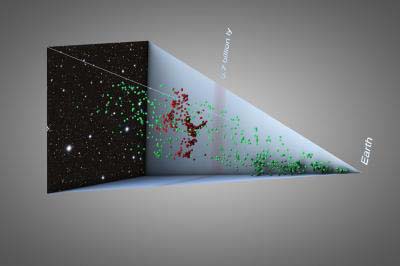
Astronomers have tracked down a gigantic, previously unknown assembly of galaxies located almost seven billion light-years away from us. The discovery, made possible by combining two of the most powerful ground-based telescopes in the world -- ESO's Very Large Telescope and NAOJ’s Subaru Telescope -- is the first observation of such a prominent galaxy structure in the distant Universe, providing further insight into the cosmic web and how it formed. This 3-D illustration shows the position of the galaxies and reveals the extent of this gigantic structure. The galaxies located in the newly discovered structure are shown in red. Galaxies that are either in front or behind the structure are shown in blue.
Physicist Makes New High-resolution Panorama Of Milky Way Science Daily - October 29, 2009
Cobbling together 3000 individual photographs, a physicist has made a new high-resolution panoramic image of the full night sky, with the Milky Way galaxy as its centerpiece. Axel Mellinger, a professor at Central Michigan University, describes the process of making the panorama in the November issue of Publications of the Astronomical Society of the Pacific.
Double Nucleus Galaxies: Ravenous Black Holes And Ripples In Space-Time Continuum Science Daily - September 15, 2009
 Brilliant 360-Degree Panorama of the Milky Way Wired - September 14, 2009
Brilliant 360-Degree Panorama of the Milky Way Wired - September 14, 2009
Planck telescope beams back first images of the fall out after the Big Bang Telegraph.co.uk - September 17, 2009
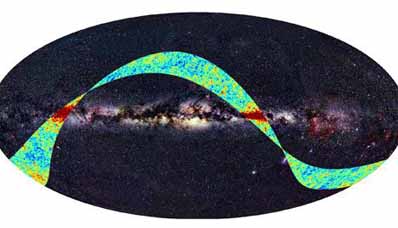
NASA's Spitzer Images Out-of-This-World Galaxy Science Daily - August 5, 2009
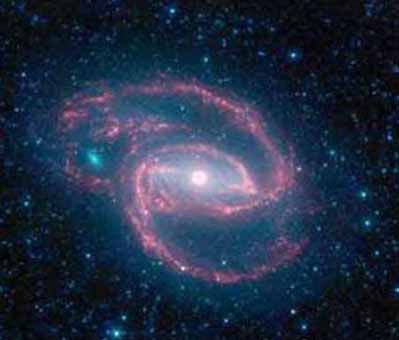
The "eye" at the center of the galaxy is actually a
monstrous black hole surrounded by a ring of stars.
Herschel space observatory - first image of Whirlpool Galaxy BBC - June 19, 2009

Milky Way's Turbulent Core in Hi-Res National Geographic - January 7, 2009
Milky Way 50 Percent Larger, Astronomers Discover Wired - January 6, 2009
There is a giant black hole at the center of our galaxy, a study has confirmed. BBC - December 10, 2008
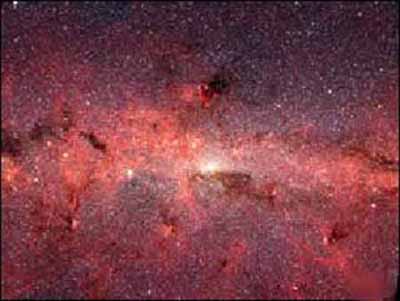
There is a giant black hole at the centre of our galaxy, a 16-year study by German astronomers has confirmed.
They tracked the movement of 28 stars circling the centre of the Milky Way, using two telescopes in Chile.
The black hole, said to be 27,000 light years from Earth, is four million times bigger than the Sun, according to the paper in The Astrophysical Journal. Black holes are objects whose gravity is so great that nothing - including light - can escape them. According to Dr Robert Massey, of the Royal Astronomical Society (RAS), the results suggest that galaxies form around giant black holes in the way that a pearl forms around grit.
Supermassive black hole at the Center of the Milky Way NASA - December 11, 2008
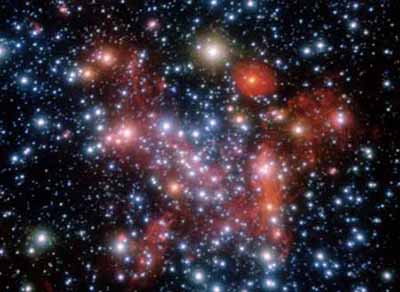
Hubble Snaps Rare Aligned Galaxies National Geographic - September 17, 2008
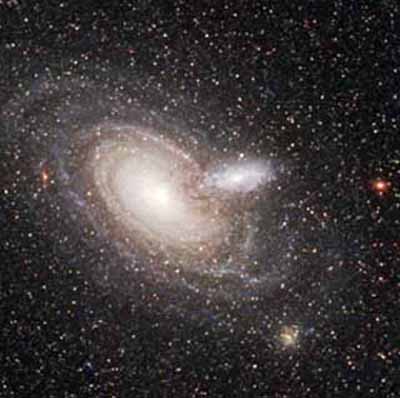
Thousand-ruby Galaxy: Pinwheel Shines In The Darkness Science Daily - September 3, 2008
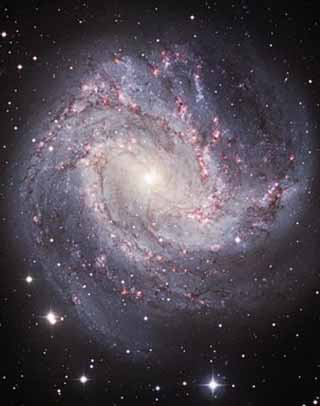
Thousand-Ruby Galaxy National Geographic - September 2, 2008
How big can a black hole grow? New Scientist - September 3, 2008

Milky Way's black hole gets extreme close-up New Scientist - September 3, 2008
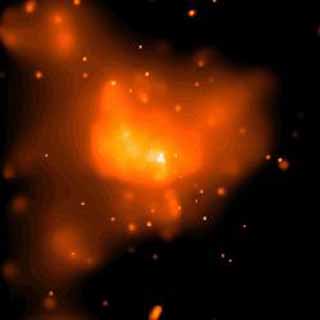
Closest Look Ever at the Edge of a Black Hole PhysOrg - September 3, 2008
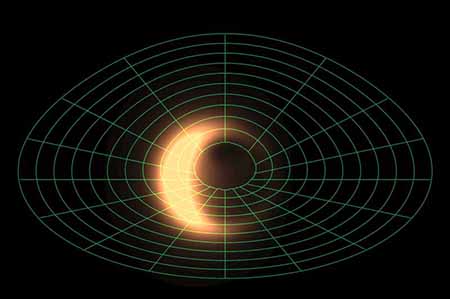
Closest Look Yet at Milky Way's Black Hole Live Science - September 3, 2008
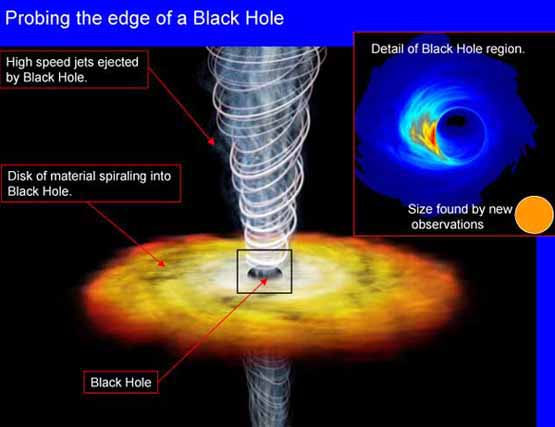
Milky Way's Halo Loaded with Star Streams Live Science - August 16, 2008
Stellar nursery found near Milky Way's violent heart New Scientist - July 24, 2008
The Exploding Star in the Milky Way That Everyone Missed Space.com - July 22, 2008
New Milky Way Map Created; Shows Two Fewer Main Arms National Geographic - June 3, 2008
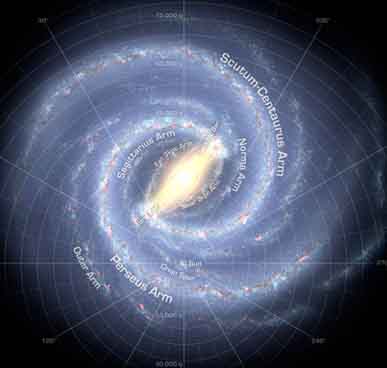
Milky Way loses two arms MSNBC - June 4, 2008
Black Holes Key to Spiral Arm Hugs Live Science - June 3, 2008
Milky Way's Giant Black Hole 'Awoke From Slumber' 300 Years Ago Science Daily - April 17, 2008
Two Supernova Factories Found In The Milky Way Science Daily - April 2, 2008
Galaxy Evolution Seen in Action BBC - April 1, 2008
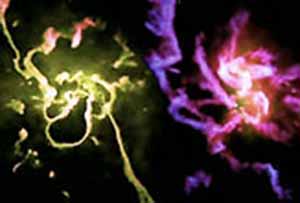
Galaxy without dark matter puzzles astronomers New Scientist - February 7, 2008
"Fossil Galaxy" Spotted by Hubble National Geographic - February 7, 2008
Cosmic Finger Taps Our Galaxy's Shoulder Space.com - February 5, 2008
Building Blocks of Life Detected in Distant Galaxy National Geographic - February 5, 2008
Milky Way's antimatter linked to exotic black holes New Scientist - January 22, 2008
Milky Way Has Mysterious Lopsided Cloud Of Antimatter: Clue To Origin Of Antimatter Science Daily - January 15, 2008
Perfectly Aligned Galaxies Found For the First Time - Double Einstein Ring National Geographic - January 12, 2008
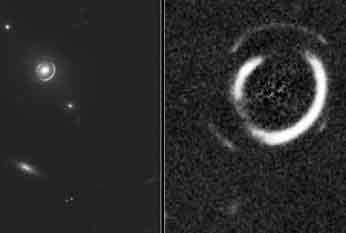
Astronomers have found three galaxies in a never before seen perfect alignment
a discovery that may help scientists better understand the mysterious dark matter
and dark energy believed to dominate the universe.The three galaxies are like beads
on a string, one directly behind the other.
Ancestors of Milky Way-Type Galaxies Found, Analyzed National Geographic - January 9, 2008
Milky Way 'ancestors' discovered BBC - January 9, 2008
Galaxy's spiral arms point in opposite directions New Scientist - January 9, 2008
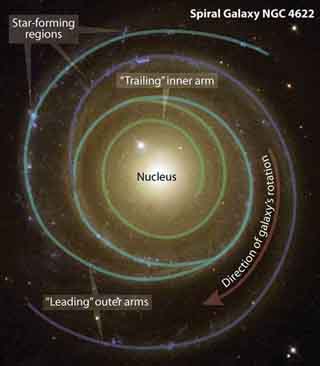
Baby Versions of Milky Way Spotted Live Science - January 9, 2008
Galaxy's antimatter may leak from black holes New Scientist - January 10, 2008
Speeding Star to Escape from Milky Way Space.com - November 29, 2007
Phantom galaxy stages celestial fireworks Guardian - November 30, 2007
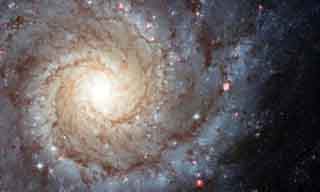
Discovering Teenage Galaxies Billions Of Light Years Away Science Daily - November 29, 2007
Dwarf Galaxy I Zwicky 18 National Geographic - October 16, 2007
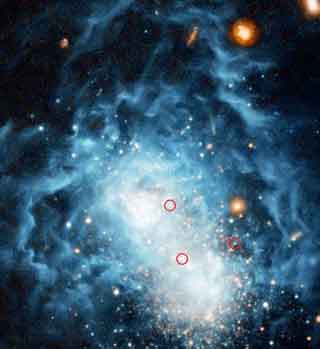
I Zwicky 18 Wikipedia
Spectroscopic observations with ground-based telescopes have shown that I Zwicky 18 is
almost exclusively composed of hydrogen and helium, the main ingredients created in the Big Bang.
Small 'Hobbit' Galaxies Made Almost Entirely of Dark Matter Live Science - September 12, 2007
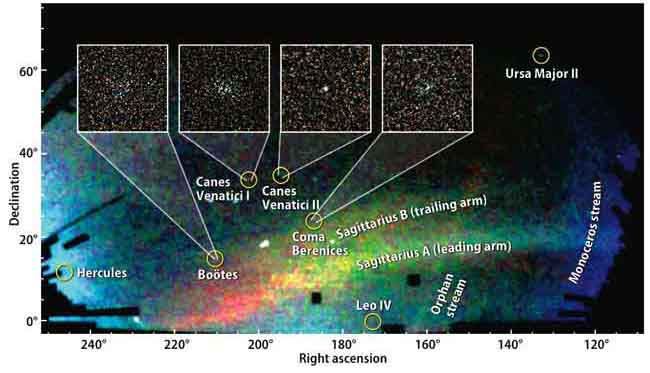
Four Galaxies Collide
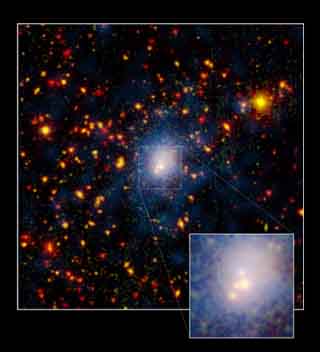
Four gigantic galaxies have been seen crashing into one
another in one of the biggest cosmic collisions ever seen.
Colossal Four-Galaxy Collision Discovered National Geographic - August 8, 2007
Galaxies clash in four-way merger BBC - August 7, 2007
Four-galaxy collision could form übergalaxy MSNBC - August 7, 2007
Giant Planets More Common, Star Survey Suggests BBC - August 6, 2007
The Four Suns of HD 98800 NASA - July 30, 2007
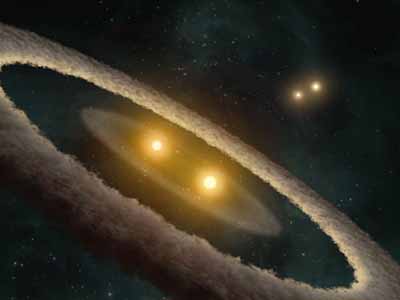
Streams of Stars Reveal Cannibal Nature of Milky Way Space.com - May 31, 2007
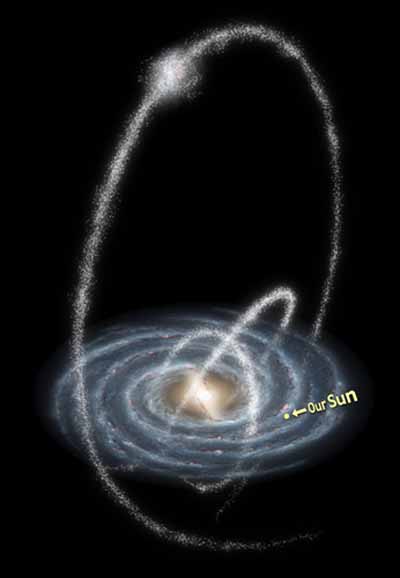
Stellar streams are thought to form over billions of years as our galaxy?s gravity slowly tears apart globular clusters and even dwarf galaxies. The stars, which were once packed tightly together, are now separated by light-years, trailing one another as they jet at high speeds through the galactic halo.
Why Are Galaxies without Black Holes Uncommon? PhysOrg - May 31, 2007
Recent calculations indicate that when two galaxies, and the supermassive black holes that lie at their centers, merge, these galactic 'marriages' frequently produce gravitational forces strong enough to kick the new combined black hole right out of its merged galaxy. However, so far, none of the many 'empty nest' galaxies predicted by such calculations have been found.
Mystery spiral galaxy arms explained? PhysOrg - April 11, 2007
Chemical composition of stars in clusters can tell history of our galaxy PhysOrg - March 22, 2007
Fundamental Rule Describes All Galaxies Space.com - March 6, 2007
Panorama reveals thousands of growing galaxies New Scientist - March 6, 2007
Galaxy survey focuses on 'pre-teen' years PhysOrg - March 6, 2007
Hubble sees 'Comet Galaxy' being ripped apart by galaxy cluster EurekAlert - March 2, 2007
First X-ray detection of a colliding-wind binary beyond Milky Way PhysOrg - February 16, 2007
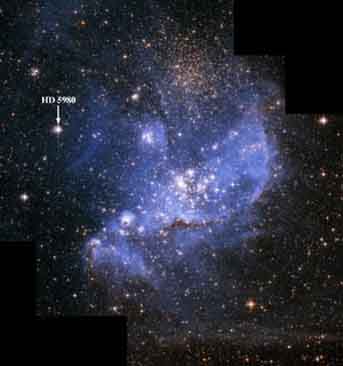
New Theory Explains Darkest Galaxies BBC - February 15, 2007
Seven or Eight Dwarf Galaxies Discovered Orbiting the Milky Way PhysOrg - January 9, 2007
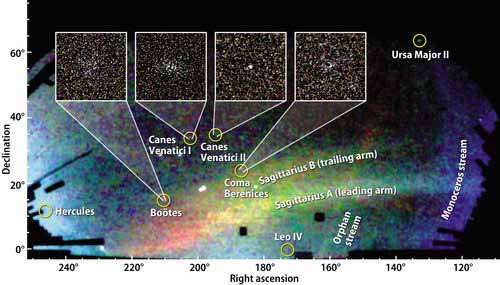
Tiny galaxy hosts huge black hole BBC - January 9, 2007
VCC128 is an elliptical dwarf galaxy, about 1% the size of our own Milky Way,
located in the Virgo Cluster, which is about 59 million light-years away.
Giant Gas Loops Found in Center of Milky Way, National Geographic- October 4, 2006
Giantic magnetic loops of gas have been discovered
arching out of the heart of our galaxy, mimicking loops of
plasma sometimes seen on the sun, only a trillion times bigger.
New Planet "Bonanza" Discovered at Center of Milky Way National Geographic - October 5, 2006
Earliest Galaxies in the Universe Spied by Astronomers National Geographic - September 16, 2006
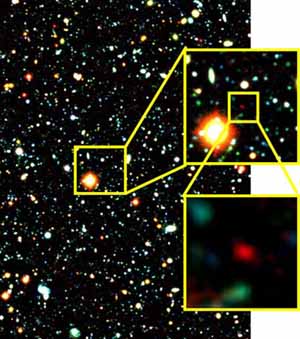
The Milky Way over Utah NASA - June 6, 2006
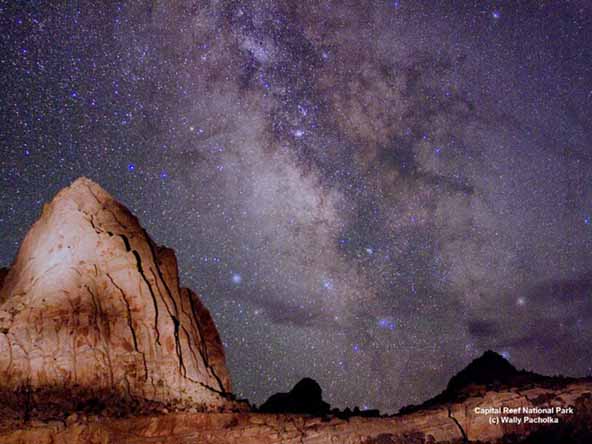
Most Milky Way Stars Are Single PhysOrg - January 30, 2006
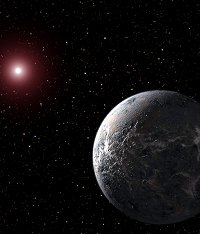
Smallest Earth-like planet found BBC - January 25, 2006
Scientists find extrasolar planet most like our own MSNBC - January 25, 2006
Microlensing detects faraway world just 5.5 times bigger than our own
Man-Made "Star" Illuminates Milky Way's Mysterious Center Scientific American - December 23, 2005
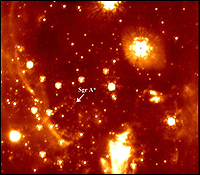
The bar is embedded in the center of the galaxy's spiral arms Space.com August 17, 2005
and cuts across the heart of it all where a supermassive black hole resides
Gemini Uncovers 'Lost City' Of Stars PhysOrg - August 17, 2005
Like archaeologists unearthing a 'lost city', astronomers using the
8-meter Gemini South telescope have revealed that the galaxy
NGC 300 has a large, faint extended disk made of ancient stars,
enlarging the known diameter of the galaxy by a factor of two or more.
High Energy Milky Way Reveals 'Dark Accelerators' Science Daily - May 31, 2005
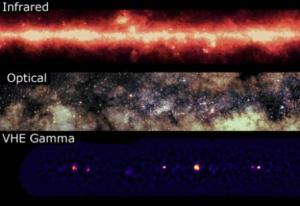
Cosmic particle accelerator seen BBC - April 2005
Astronomers have discovered a loop-like structure some
20 light-years across close to the center of the Milky Way
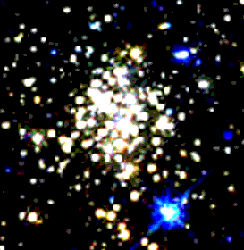
Galactic pancake mystery solved BBC - April 2005
Astronomers have figured out why a series of
small galaxies surrounding the Milky Way are
distributed around it in the shape of a pancake
New Sources of High-Energy Gamma Rays Discovered at Galaxy's Center Scientific American - April 2005
Astronomers Map Chaotic Galaxy's Magnetic Field Scientific American - March 2005
Radio Waves Detected Coming From Center of Galaxy National Geographic - March 2005
Astronomers find star-less galaxy BBC - February 2005
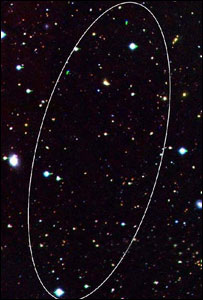
Astronomers say they have discovered an object that appears
to be an invisible galaxy made almost entirely of dark matter
Astronomers Spy Galaxy's Strongest Explosion Yet Scientific American - February 2005
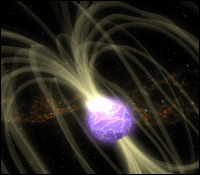
Huge 'star-quake' rocks Milky Way BBC - February 2005
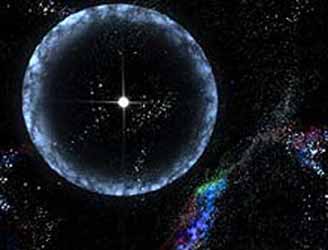
See-through Galaxy: Revealing The Milky Way's Center Science Daily - January 2003
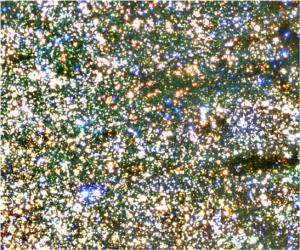
The center of our galaxy is hidden behind a "brick wall" of obscuring
dust so thick that not even the Hubble Space Telescope can penetrate it.
Astronomers witness huge galactic collision MSNBC
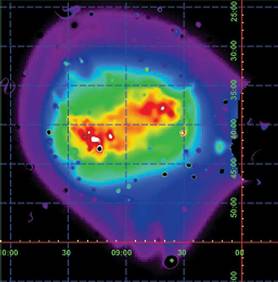
Stars reveal the Milky Way's age BBC - August 2004

estimated by astronomers as being about 13,600 million years old
Chandra captures galaxy cluster forming BBC - August 2004
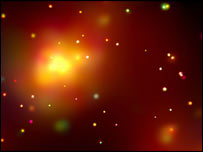
Hubble sights Milky Way's 'twin' BBC - August 2004
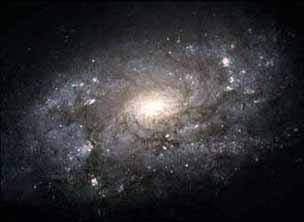
NGC 3949 is a large spiral galaxy and, in astronomical
terms at least, is relatively nearby at around 50 million
light-years away from Earth.
Hubble discovers 100 new planets orbiting stars in our galaxy in galactic bulge BBC - July 2004
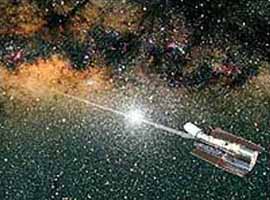
If confirmed it would almost double the number of planets known
to be circling other stars to about 230. The discovery will lend
support to the idea that almost everysunlike star in our galaxy,
and probably the Universe, is accompanied by planets.
Milky Way X-ray Mystery Deepens Scientific American - July 2004
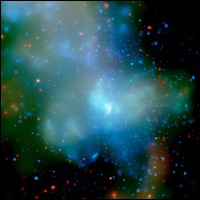
What is the glow in the center of our galaxy?
Origin Of Enigmatic Galactic-center Filaments Revealed Science Daily - June 2004
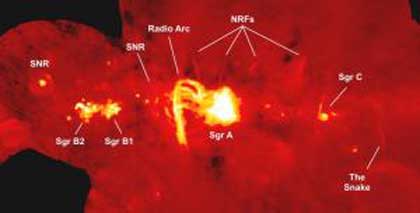
Distant galaxies line-up in space BBC - February 2004
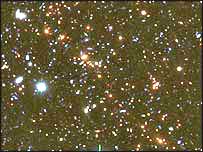
Astronomers are puzzled by an image of a distant cluster of galaxies in which
they are lined up like a string that is stretched across the Universe.
Hubble sees 'most distant object' BBC - February 2004
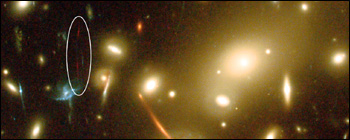
The farthest object in the Universe yet detected has been seen by scientists
using the Hubble and Keck telescopes. It is so distant its light must have set
out when the Universe was just 750m years old to reach the Earth now.
Aliens in our galaxy? Experts map possible hotbeds National Geographic - January 6, 2004
Scientists say a ring-shaped region in the disc of the Milky Way shows the highest potential for life in our galaxy. But don't expect them to find extraterrestrial life anytime soon: In this region, there are some 20 billion star systems that offer the prerequisites of life. The team of astronomers has identified stars that contain enough heavy elements to form terrestrial planets; are sufficiently distant from disastrous supernova explosions; and have existed for at least four billion years - the time it took for complex life to evolve on Earth. Using a sophisticated computer evolution model, they found that ten percent of the stars in our galaxy, located in a ring around the center of the Milky Way, meet those criteria.
Astronomers See Era Of Rapid Galaxy Formation; New Findings Pose A Challenge For Cold Dark Matter Theory Science Daily - January 9, 2004
"The universe is always more complicated than our cosmological theories would have it," says Nigel Sharp, program officer for extra-galactic astronomy and cosmology at the National Science Foundation (NSF). Witness a collection of new and recently announced discoveries that, taken together, suggest a considerably more active and fastmoving epoch of galaxy formation in the early universe than prevailing theories had called for. The findings, each of which was obtained at facilities supported in whole or in part by the NSF, include the following:
Astrophysicists Discover Massive Forming Galaxies Science Daily - September 12, 2003
The forming galaxies were detected at sub-millimeter wavelengths. Emission at these wavelengths is due to dust from young stars that is heated by the stars or by active black holes. The galaxies were grouped around high-red shift radio galaxies, the most massive systems known, suggesting that they all formed at approximately the same time. In the present universe, the most massive galaxies are elliptical galaxies, which are found in the centers of rich galaxy clusters. The stars in these galaxies are now old, and must have formed at much earlier times. The enormous bursts of star formation that build these galaxies produce large quantities of dust that can be observed at submillimeter wavelengths.
Scientists Determine Large Magellanic Cloud Galaxy Formed Similar To Milky Way Science Daily - September 12, 2003
The oldest and most metal-poor Milky Way stars form a spherical halo where they move about like atoms in a hot gas, which in turn prompts two major formation scenarios of our galaxy: extended hierarchical accretion and rapid collapse. RR Lyrae stars, which are found both in the Milky Way and the LMC, are excellent tracers of old and metal-poor populations. By measuring the movement of 43 RR Lyrae stars in the inner regions of the LMC, the team determined that a moving hot, metal-poor, old halo also exists in the LMC, suggesting that the Milky Way and smaller, more irregular galaxies like the LMC have similar early formation histories.
Most distant galaxy detected - 12.8 billion light-years away BBC - March 2003
The Japanese Subaru Telescope has found a galaxy 12.8 billion light-years away, the most distant galaxy ever observed. This discovery is the first result from the Subaru Deep Field (SDF) project which has discovered about 70 distant galaxy candidates by using a special filter to locate galaxies around 13 billion light-years away. Researchers say the discovery raises hopes that they will be able to find a large number of distant galaxies that will help unravel the early history of the Universe in a statistically meaningful way.
They hope to find out more about the period between the Big Bang and the formation of the first stars and galaxies, after the mysterious so-called "dark ages"
Milky Way's star 'doughnut' BBC - January 6, 2003
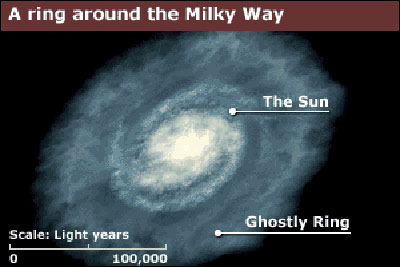
A vast, but previously unknown structure has been discovered around the edges of our galaxy, the Milky Way. The first large area surveys of the sky have revealed several hundred million stars surrounding the galaxy's main disc. The ring, which has the appearance of a giant doughnut, could be the remains of a satellite galaxy. Astronomers believe it could hold clues as to how the Milky Way and other galaxies evolved.
Hubble watches galactic dance BBC - December 16, 2002
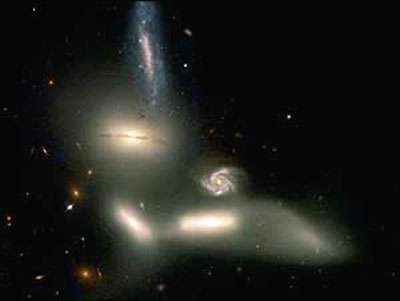
The Hubble Space Telescope is witnessing a cluster of galaxies perform a slow dance of destruction that will last billions of years.
The galaxies' gravity is beginning to rip stars from them and distort their shapes. Eventually, they will merge to form one large galaxy.
The grouping, called Seyfert's Sextet, implies that six galaxies are coming together but in reality only four are. The small face-on spiral with the prominent arms of gas and stars is a background galaxy almost five times farther away than the other four. The sixth member of the sextet is not a galaxy at all but a river of stars torn from one of the galaxies.
Galaxy's dark centre exposed BBC - October 2002
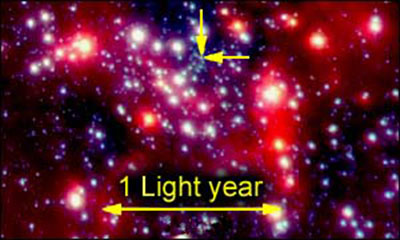
There now seems little doubt that a supermassive black hole resides at the centre of our galaxy, the Milky Way. Scientists say they have produced the best evidence yet to confirm the object's existence. It comes from observations of a fast-moving star which orbits close to the hole, referred to by astronomers as Sagittarius A* (its location in the sky is in the southern constellation Sagittarius)
Spiral galaxy winds up astronomers BBC - February 11, 2002
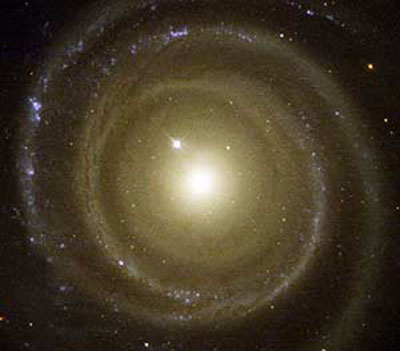
This galaxy is spiraling backwards. The beautiful but strange galaxy NGC 4622 is confounding astronomers as it appears to break all the rules about how galaxies should rotate. All so-called spiral galaxies seem to rotate in such a way that the spiral arms are winding up, even though their galactic arms do not become crowded together because stars move in and out of them all the time. This is the density wave theory that explains why the often beautiful stellar arms of a spiral galaxy are long-lived features and do not become smeared out. But the galaxy called NGC 4622 appears to be rotating in the opposite direction to that expected throwing astronomers into confusion.
Our galaxy - from the outside BBC - January 31, 2002
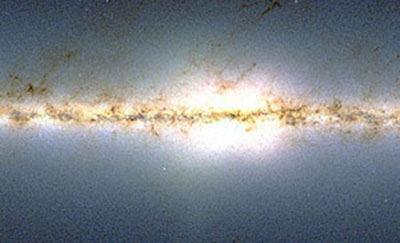
This is our home galaxy as it might look if you could travel outside it and look back. Astronomers obtained this perspective by analyzing half a billion stars measured by the Two Micron All Sky Survey (2MASS). It features the Milky Way's complete disc and its newly discovered central bar of stars. The new map will help scientists confirm the existence of hitherto only suspected features in our galaxy.
Telescope snaps 'perfect spiral' BBC - October 2, 2001
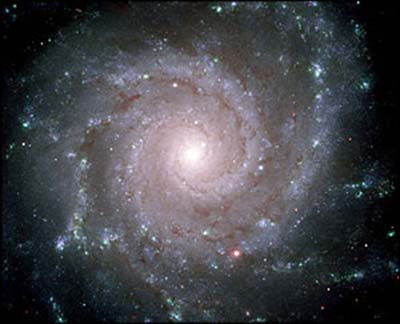
The Gemini North Telescope on Hawaii's Mauna Kea has taken a remarkable image of a galaxy 30 million light-years distant. Astronomers say the quality of the image demonstrates the great potential of a new instrument recently attached to the telescope.
The new sensor is called GMOS, or the Gemini Multi-Object Spectrograph. It is able to record the spectra of hundreds of objects in an image, something that will be useful in many branches of astronomy.
GALAXIES
ASTRONOMY INDEX
ALPHABETICAL INDEX OF ALL FILES
CRYSTALINKS HOME PAGE
PSYCHIC READING WITH ELLIE
2012 THE ALCHEMY OF TIME



































































